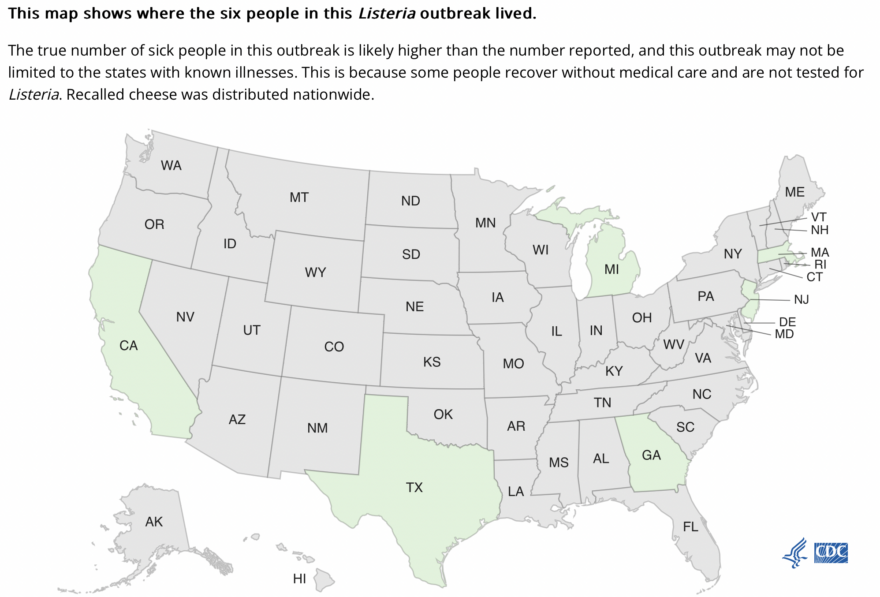CDC, public health and regulatory officials in several states, and the U.S. Food and Drug Administration (FDA) are collecting different types of data to investigate a multistate outbreak of Listeria monocytogenes infections.
Epidemiologic, traceback, and laboratory data show that cheese made by Old Europe Cheese, Inc. may be contaminated with Listeria and may be making people sick.
Epidemiologic and Traceback Data
As of September 28, 2022, six people infected with the outbreak strain of Listeria have been reported from six states (see map). Sick people’s samples were collected from August 6, 2017, to August 5, 2022 (see timeline).

Sick people range in age from 56 to 83 years, with a median age of 78, and 67% are female. Five people have been hospitalized, and no deaths have been reported.
The true number of sick people in this outbreak is likely higher than the number reported, and the outbreak may not be limited to the states with known illnesses. This is because some people recover without medical care and are not tested for Listeria. In addition, recent illnesses may not yet be reported as it usually takes 3 to 4 weeks to determine if a sick person is part of an outbreak.
State and local public health officials are interviewing people about the foods they ate in the month before they got sick. Of the five people interviewed, four (80%) reported eating brie or camembert cheese. Most people did not remember the brand of the cheese they ate, but one person reported eating Lidl Premium Brand Brie. Old Europe Cheese is the only manufacturer of Lidl Premium Brand Brie.
Laboratory Data
Public health investigators are using the PulseNet system to identify illnesses that may be part of this outbreak. CDC PulseNet manages a national database of DNA fingerprints of bacteria that cause foodborne illnesses. DNA fingerprinting is performed on bacteria using a method called whole genome sequencing (WGS).
WGS showed that bacteria from sick people’s samples are closely related genetically. This suggests that people in this outbreak got sick from the same food.
FDA, with assistance from the Michigan Department of Agriculture and Rural Development, inspected the Old Europe Cheese facility in Michigan and collected samples for testing. WGS showed that the Listeria found in the cooling room is closely related genetically to Listeria from sick people’s samples. This provides more evidence that people likely got sick from eating cheese made by Old Europe Cheese.
Public Health Actions
CDC is advising people not to eat, sell, or serve recalled cheese.
On September 30, 2022, Old Europe Cheese, Inc. recalled their brie and camembert cheese. The company has also temporarily stopped producing these cheeses.

Brie, baked brie, and camembert cheese made by Old Europe Cheese, Inc.
- Sold under multiple brand names
- Black Bear
- Block & Barrel
- Charmant
- Cobblestone
- Culinary Tour
- Fredericks
- Fresh Thyme
- Glenview Farms
- Good & Gather
- Heinen’s
- Joan of Arc
- La Bonne Vie
- Lidl
- Life in Provence
- Market 32
- Matrie’d
- Metropolitan
- Prestige
- Primo Taglio
- Red Apple Cheese
- Reny Picot
- St. Louis
- St. Randeaux
- St. Rocco
- Taste of Inspiration
- Trader Joe
- Sold at stores nationwide in the US and Mexico
- Albertsons
- Giant Foods
- Lidl
- Stop & Shop
- Whole Foods
- And many more
- Best-by dates from September 28, 2022, to December 14, 2022
- See recall notices for a full list of product names, UPC codes, and stores